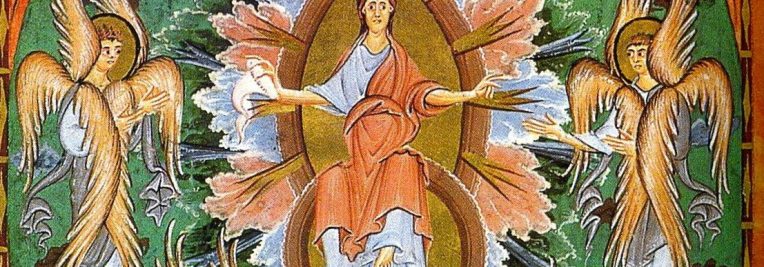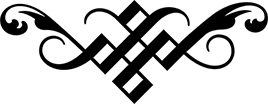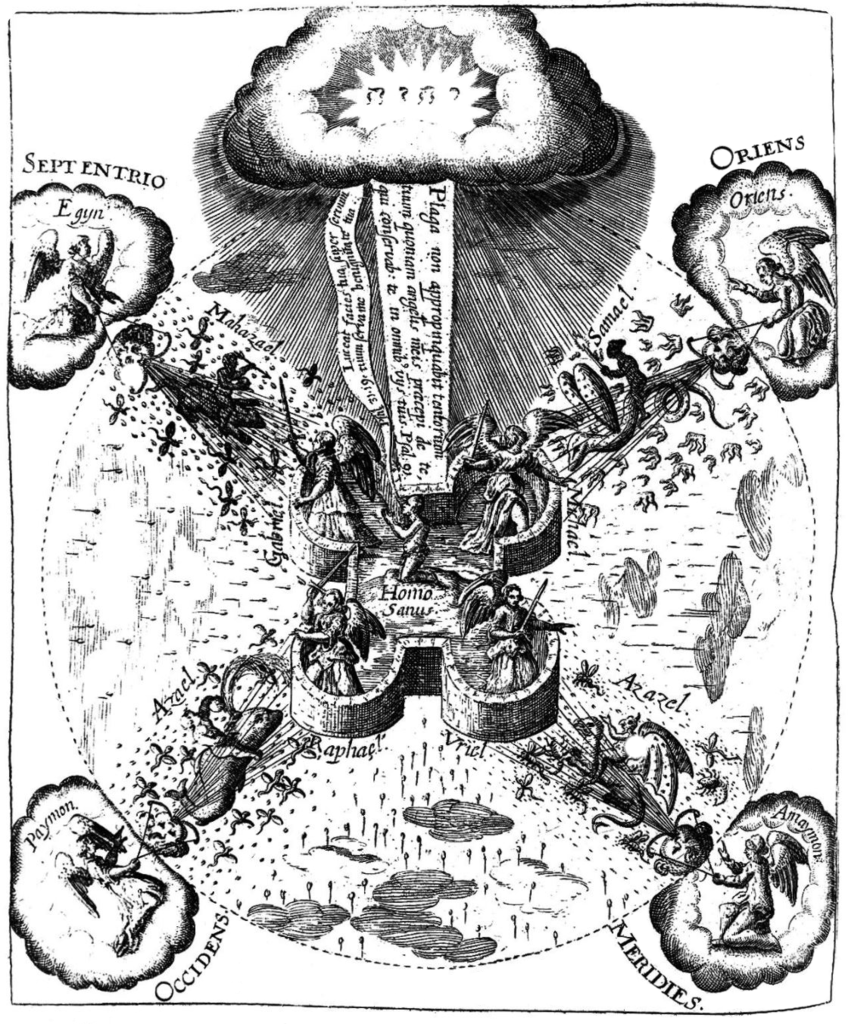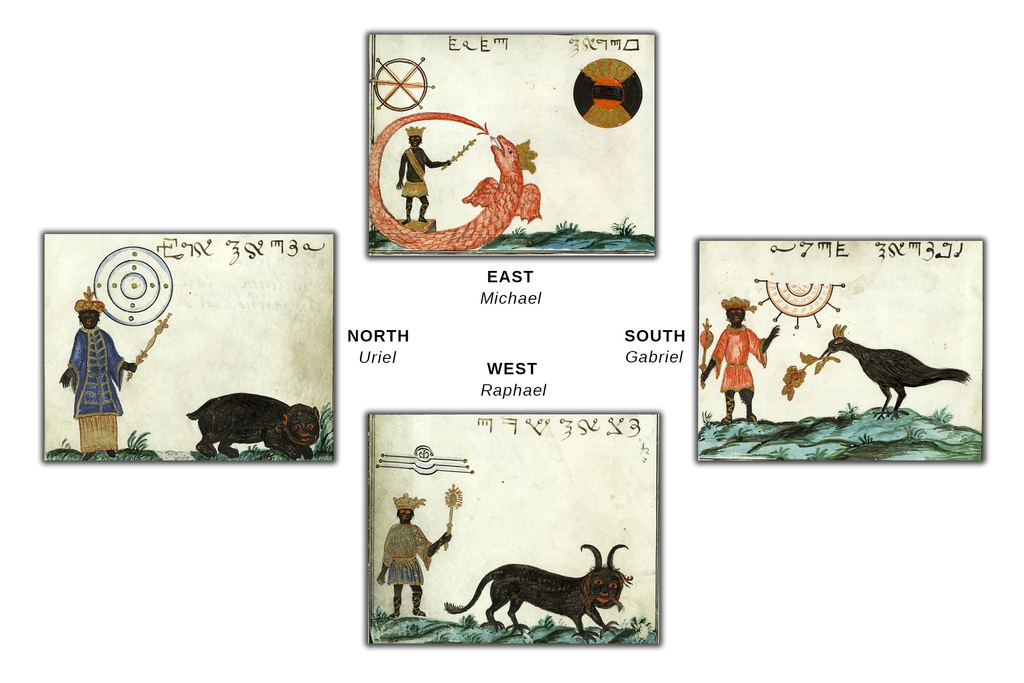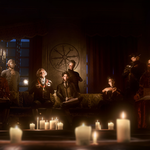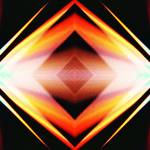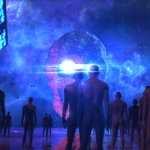This article came out of a seemingly simple question, which I thought might be readily drawn back to an original source. As with many things, though, there is no single answer and a whole world of information opens up as a result of digging just beneath the surface.
The piece below looks at the precedents for a well known ritual in contemporary sacred magic, which takes us on a journey back through early scriptural references; to the grimoire tradition of the middle ages; and then to the birth of Rosicrucianism in the 17th-century and on to the Victorian occult revival.
It’s worth stating from the outset that I am not a religious or historical scholar, although I have been an active aspirant and practitioner of various forms of (mostly Christian) esotericism for the better part of 20 years. This write-up is also necessarily shorter than it would need to be to do the topic full justice. Rather than trying to match academic or theological standards that are beyond my reach, it is instead an exploration intended for those who are seeking to work with the archangels mystically or magically and so will try to frame the research done in a manner most suited to those paths.
Even after 20 years I feel like my journey is just beginning, so this exploration is part of solidifying aspects of my own practice. This might mean that it falls short for some readers, but hopefully it will do enough to inspire others as we journey along similar paths.
For those less interested in mystical or esoteric practices, perhaps there is something to be gained from the exercise in textual analysis. Just know that the act of writing this was part of the journey of discovery and development of practice that I required at this point in time. It is not a final answer of wisdom handed down from lofty heights of attainment, but rather a question to be explored openly that will be worked with and evolve.
The findings presented here are therefore a work in progress and part of an ongoing exploration. If anybody reading has extra information or some good references for further study, I would love to hear from you!

Before me Raphael,
Behind me Gabriel,
On my right hand Michael,
On my left hand Uriel…
These are words that anybody interested in Western esotericism soon becomes familiar with, forming a vital part of perhaps the most important ritual in all of modern ceremonial magic: the Lesser Banishing Ritual of the Pentagram (LBRP) from the Hermetic Order of the Golden Dawn (G.:D.:). Variations are used throughout different esoteric orders, but it is almost universally recognised that this ritual is of such importance that it should be performed in some form daily and indefinitely throughout one’s spiritual journey.
I have regularly been using a modern Rosicrucian variation and have always taken at face value the assignment of their respective stations when invoking the four archangels. The ritual is normally conducted facing East, so they are assigned to particular cardinal points as expressed through relation to the practitioner. You come across alternate placements, and most people take the approach that as long as something is consistent (and properly understood) then the exact details are usually fluid. It is the intention with which they are done which is the important part.
An Illustration from Robert Fludd
So far, so good and I would have continued down that path indefinitely were it not for a recent image that piqued my curiosity, from a text by Robert Fludd entitled Integrum morborum mysterium… (1631).
Filled with fascinating illustrations of alchemical and magical importance, there was a series of images (and one in particular) that caught my attention:
This 17th-century illustration is a near perfect representation of both the Qabalistic Cross and the Invocation of the Archangels that form two of the three components of the LBRP ritual of the late 19th-century (it even has a dotted circle around the space created, which you could say represents the casting of the circle). The image depicts a man fervently praying, with the four archangels protecting him from four demonic forces (Azael / Makazael / Samael / Azazel) carried by the cardinal winds, while the radiant light of YHVH, the Tetragrammaton, shines down in a column into the fortress of faith and devotion that has been created.
The directions of the winds and their associated names follows the convention put forward by St. Isidore of Seville (c.600CE):
Oriens: the rising sun, morning [East]
Meridies: mid day, after noon [South]
Occidens: sun set [West]
Septentrio: divide [North]
And as illustrated in this manuscript from the 12th-century (note the directional ‘before me’ is indicated as Oriens/East at the top):
Indeed, +Isidore not only goes into great detail on the hierarchies of angels in Book VII of his Etymologiae (c.630 CE), but also gives us a connection to the winds through the reasoning of why both angels and winds are said to have wings:
The term for angels is thus the name of their function, not of their nature. Indeed they are always spirits, but when they are commissioned they are called angels. For this reason the license of artists makes wings for them, to signify their swift course on all their missions, just as in poetic fiction the winds are said to have wings to indicate their speed. Whence also Holy Scripture says (Psalm 103:3 Vulgate), “Who walketh upon the wings of the winds.”
Etymologiae – Book VII: Gods, Angels and Saints
This piece won’t go into more detail about the meaning of the cardinal directions and winds or their origins, but it’s interesting to note how the archangels are associated with cardinal directions which gives a further direction of inquiry on different associations. Same with the order of the four elements with which the archangels are often linked and discussed, that often change depending on the sources used or intended purpose of specific ceremonial workings.
There is also a worthwhile exploration to be made into the four Kerubic emblems as found in Ezekiel 1:10 (with a slight variation in Ezekiel 10:14):
As for the appearance of their faces: the four had the face of a human being, the face of a lion on the right side, the face of an ox on the left side, and the face of an eagle.
Ezekiel 1:10 (NRSV)
But looking at the above image from Fludd, specifically, and considering how close a representation it is of the ceremonial form and purpose of the LBRP ritual, it begs the question: why is the positioning of the archangels different?
This is particularly curious as Robert Fludd plays a prominent role in the birth of Rosicrucianism in the 17th-century and influence on the Orden des Gold- und Rosenkreutz of the 18th-century; that eventually leads through to the formation of the Societas Rosicruciana in Anglia (SRIA) in the mid-19th century and then to the founding of the G.:D.: not long after by some of the SRIA’s most prominent members.
The 17th-century illustration from Fludd gives us:
Michael (East) / Uriel (South) / Raphael (West) / Gabriel (North)
Compared to the 19th-century LBRP ritual which has:
Raphael (East) / Michael (South) / Gabriel (West) / Uriel (North)
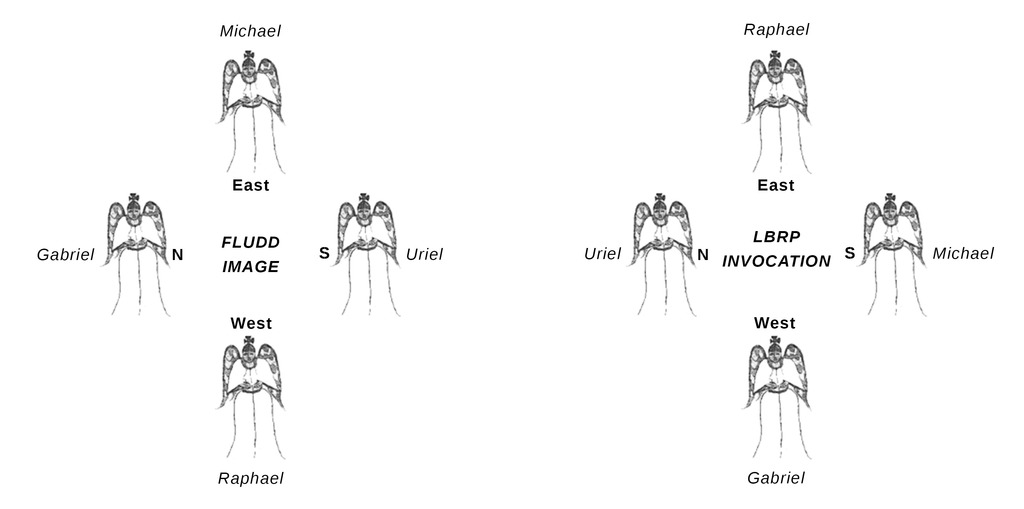
Even if we consider the facing of the praying man in Fludd’s illustration as aligning with ‘Before Me, Raphael’, the order of the archangels still doesn’t match up.
Hence my journey of discovery began…
Early Sources of the Four Archangels/Directions
The notion of archangels as part of a divine hierarchy was solidified primarily by the work of St Thomas Aquinas and also pseudo-Dionysius the Areopagite, who compiled an angelic hierarchy in his book The Celestial Hierarchy that outlines a series of three spheres of angels in nine choirs.
It’s helpful to start (and end) our journey with the words of pseudo-Dionysius, who was quite clear that our visualisations of angelic beings are all but necessary illusions:
We cannot, as mad people do, profanely visualise these heavenly and godlike intelligences as actually having numerous feet and faces…We must not have pictures of flaming wheels whirling in the skies, of material thrones made ready to provide a reception for the Deity, of multicoloured horses, or of spear-carrying lieutenants…The Word of God makes use of poetic imagery when discussing these formless intelligences but, as I have already said, it does so not for the sake of art, but as a concession to the nature of our own mind.
The Celestial Hierarchies – Chapter II
Previous to this and of more immediate relevance to our question is the Book of Enoch, a Hebrew apocalyptic text in multiple sections dating back to c.100 – 300 BCE.
The Book of Enoch gives us the notion that “on the four sides of the Lord of Spirits I saw four presences” (XL.2) and goes on to discuss the actions of these ‘voices’ in their blessings, prayer, supplication and “fending off the Satans and forbidding them to come before the Lord of Spirits” (XL.7).
These four presences are then named as:
This first is Michael, the merciful and long-suffering: and the second, who is set over all the diseases and all the wounds of the children of men, is Raphael; and the third, who is set over all the powers, is Gabriel; and the fourth, who is set over the repentance unto hope of those who inherit eternal life, is named Phanuel. And these are the four angels of the Lord of Spirits and the four voices I heard in those days.
The Book of Enoch – XL.9
In similar fashion we have the words in a sermon of Pope Gregory I (c.595 CE) that give us some Catholic representations to work with:
Whenever something is to be done needing great power, Michael is sent forth so that from his action and from his name we can understand that no one can do what God can do. Hence that old enemy who through pride desired to be like God, saying, “I will scale the heavens, I will set up my throne, I will be like the Most High,” is shown at the end of the world left to his own strength, and about to undergo the final punishment, as destined to fight with Michael the Archangel. Similarly, Gabriel was sent to Mary; he who is called “strength of God” came to announce Him who deigned to appear in humility to conquer the powers of the air. And Raphael is interpreted, as we said, “Medicine of God,” for when he touched the eyes of Tobias to do the work of healing, he dispelled the night of his blindness.
A Sermon of Pope St. Gregory the Great
Stepping back to biblical scripture, around 95 CE we have the striking quote from the Book of Revelation that combines four angels with the notion of ‘holding back the winds’ (as in Fludd’s depiction):
7 After this I saw four angels standing at the four corners of the earth, holding back the four winds of the earth so that no wind could blow on earth or sea or against any tree. 2 I saw another angel ascending from the rising of the sun, having the seal of the living God, and he called with a loud voice to the four angels who had been given power to damage earth and sea, 3 saying, “Do not damage the earth or the sea or the trees, until we have marked the servants of our God with a seal on their foreheads.”
Revelation 7:1-3 (NRSV)
There is also the Testament of Solomon, a text written in Greek which is said to have precedents also going back to the 1st-century CE. This is arguably the foundation text of the Solomonic grimoire tradition, as it outlines how the Archangel Michael gives King Solomon a magic ring with which to rule over demons. As an early precedent for the question at hand, there are some intriguing lines in there as different demons tell Solomon that they can be rebuked by certain archangels:
Jumping ahead for a moment, there is a widely referenced Jewish folk prayer reportedly from the middle ages, still used today, that gives us another variation in both cardinal directions and ‘in the round’ (note also the reference to Shechinat El which we will come back to):
To my right Michael and to my left Gavriel, in front of me Uriel and behind me Rafael, and above my head Shechinat El.
This prayer is often connected with the idea that much of the early Jewish and Christian teaching on angels was derived from Zoroastrianism. This certainly seems to be the case in a way directly relevant to our current question, when we consider the ancient Babylonian invocation (as outlined in this text from 1939, which itself is referencing the work of Shabbethai Horowitz):
Shamash before me, behind me Sin, Nergal at my right, Ninib at my left
Presuming this is an accurate depiction, and even though the names being invoked have been changed (although deeper study may find similarities), this gives us the earliest known indication of the ceremonial structure. This Babylonian prayer would take us back to around the 17th-century BCE; which means the ritual being conducted is an ancient one indeed, even if the form varies according to the different habits worn by those using it.
Following along the same lines, but this time in relation to the cardinal directions, is an early text of Jewish mysticism, the Sefer Ha-Razim, that has been accepted as belonging to a period of around the late 3rd- or early 4th-century CE. Essentially an eclectic tome of magical enchantments and spells (some of them quite gruesome in construction and/or effect), a familiar phrase jumps out near the beginning of the text (taken from the 1983 translation by Michael Morgan):
Thus, in similar fashion to the ancient Babylonian incantation, albeit for violent intent, we have the invocation of four angels connected to specific directions at the beginning of the magical operation. These aren’t the archangels of concern to us today, but it shows another reference to the structural concept that appears to come from Babylonian sources through into early Jewish magical practices. Interestingly, this structure is not repeated for any of the other spells or incantations included in the rest of the manuscript and only appears once – which is likely a result of the fact that it is a modern reconstruction from a collection of various sources.
Another early text of Jewish mysticism is the Sefer Yetzirah (Book of Formation) which is generally considered to be of a similar period of the Sefer Ha-Razim around 200 – 300 CE.
Of particular interest to the question at hand is that this text was translated into English in 1887 by William Wynn Westcott, the third Supreme Magus of the SRIA and subsequent G.:D.: co-founder. It is this text that provides us with the configuration of Sephiroth and their respective paths, but also the connection with the elements (specifically Spirit / Air / Water / Fire), and a process of ‘sealing’ creation with the sacred name IHV that has a familiar structure:
Note how this text combines the cardinal directions with a relative facing, giving us a highly relevant precedent to say that ‘Before Me’ and ‘East’ are to be considered one and the same (and also directly relevant to the Rose Cross Ritual from the G.:D.: that is often combined with the LBRP).
Interestingly, one of the translations of the Quran places the appearance of Gabriel to the Prophet Muhammad (ﷺ) before him to the East:
And indeed he (Muhammad (Peace be upon him)) saw him [Jibrael, (Gabriel)] in the clear horizon (towards the east).
Surah At-Takwir 81:23 (MK)
And I can’t help but bring up here that one of the hadith describes Gabriel in particularly awe-inspiring form:
Abdullah (bin Mas`ud) informed us that Muhammad had seen Gabriel with six hundred wings.
Sahih al-Bukhari 4857
Quite a difference between the gently kneeling and lily-holding depiction we might be used to seeing in Renaissance art!
There is also one final text here that might prove of importance, but with which there doesn’t seem to be consensus on when it was first written, which is the Harba de-Moshe (Sword of Moses). Most likely from around the 11th-century, it opens with an interesting concept:
(There are) four angels who are appointed over the sword given from the mouth of ‘H WH YH WH HYH, the Lord of the mysteries, and who are appointed over the Torah, and they observe the depth of the mysteries of the lower and upper (realms).
Harba de-Moshe (Sword of Moses)
The few reference points above are just a small glimpse into the transmission of these ideas from ancient times through to the Talmudic period; before combining with the archangels of early Judeo-Christian sources and arriving in a Jewish prayer of the middle ages that bears a near-perfect similarity to the LBRP ritual of the 19th-century (albeit with a different configuration). There will be countless more examples that could be added to build a more complete picture, but these are enough to show that there is a chain of tradition/s running throughout deserving of more detailed exploration.
Kabbalah and the Grimoire Tradition of the Middle Ages
When I asked the question about the placement of the archangels of some Rosicrucian peers, the recommendation came back that it would prove fruitful to look into the grimoire tradition as it likely emerges from such texts. There was also a suggestion that the G.:D.: configuration might step back to the works of Frederick Hockley, who was a member of the Societas Rosicruciana in Anglia and therefore close with many of the G.:D.: founders on both personal and practical fronts. Hockley was an erudite and prolific practitioner of sacred magic, particularly angelic scrying ala John Dee, and was highly influential in reinvigorating the grimoire tradition of Europe through his works in the 19th-century.
Forgive me if what comes next feels a bit disjointed as we jump from Jewish mystical texts through one grimoire to the next (my knowledge of this area is growing slowly), but explorations into how this invocation of the archangels might have emerged from the grimoire tradition (which was heavily influenced by Kabbalah) quickly starts to uncover some important reference points.
The grimoire tradition, building off a resurgence of Jewish mysticism and Christian theurgy, starts to become prominent around the 13th-century with publications of texts such as the Sefer Ha-Zohar (Book of Splendour) and the Sefer Ha-Bahir (Book of Illumination) and drawing upon the more ancient mystical cosmology of the Sefer Yetzirah (Book of Formation) and Sefer Ha-Razim (Book of Secrets) mentioned above.
Building upon the early references shown above in the Sefer Yetzirah and Sefer Ha-Razim, there are two kabbalistic texts dated to the 13th-century that pick up the thread. To start with, the configuration of the four archangels is found in the Sepher Ha-Zohar, perhaps the most widely known text in the Jewish kabbalistic tradition, in which the four holy angels are seen as emerging from and accompanying Shekinah (as the Throne of God):
… As we have learnt, “one” alludes to above, below, and the four quarters of the universe, these being the supernal Chariot, so that all are embraced in a single unity reaching out to the En-sof (Infinite)
Soncino Zohar, Shemoth, Section 2 [referring to Ezekiel’s vision]
The faces turned toward the four cardinal points, each with its own likeness, but all combined with the likeness of man. Michael was on the right, Gabriel on the left, Uriel in front, and Raphael behind, while the Shekinah was hovering over them all. Thus there were two on each side with the Shekinah in the centre.
Soncino Zohar, Bemidbar, Section 3
Thus, in the kabbalistic tradition delineated in the Zohar and taking its lead from the vision of Ezekiel, the four archangels combine to create the Throne of God upon which the Shekinah (the dwelling of God in the world) is able to descend upon us.
The invocation of the archangels, then, can be seen as the formation of a temporal space within which an aspect of the eternal Shekinah can be present and the aspirant immersed within Divine Providence with the intention of becoming one with its revelatory mission. The ritual is thus not merely a ‘banishing’ as it is primarily considered (and which forms part of the ceremony); but an invocation of the presence and providence of God in the material world as embodied within the aspirant.
Here’s a good write-up from the Jewish mystical perspective which goes into considerable detail and includes more sources than I have here, but in summary there is predictably no consensus and the directional attributions seem to be a later addition to the concept that the archangels are placed in reference to the Throne of God/Glory; which itself has no specific direction of facing or positioning of the angels around it.
Before moving on to the grimoire tradition proper, it’s also worth noting that there are relevant depictions of the archangels in a few descriptions in a 12th-century manuscript of the Sefer Ha-Bahir (attributed to the 1st-century CE, but likely of much later origin contemporary to the Zohar):
This teaches us that Michael, the prince to God’s right, is water and hail, while Gabriel, the prince to God’s left, is fire.
Sefer Ha-Bahir – Section 1:11
All agree that none were created on the first day. It should therefore not be said that Michael drew out the heaven at the south, and Gabriel drew it out at the north, while God arranged things in the middle
Sefer Ha-Bahir – Section 2:22
And who are the Officers? We learned that there are three. Strength (Geburah) is the Officer of all the Holy Forms to the left of the Blessed Holy One. He is Gabriel. The Officer of all the Holy Forms to His right is Michael. In the middle is Truth. This is Uriel, the Officer of all the Holy Forms [in the centre]
Sefer Ha-Bahir – Section 3:108
Note that Sefer Ha-Bahir gives us a connection also to the Qabalistic Cross and the Hebrew use of Geburah in the opening section of the LBRP ritual; but perhaps more interestingly, there are only three archangels mentioned in the text and it leaves out Raphael but includes Uriel whom is often given more prominence in the Jewish tradition.
Moving now to the grimoire tradition proper, we have the Liber Juratus Honorii (Sworn Book of Honorius), a 13th-century grimoire that was one of the earliest comprehensive texts in the grimoire tradition and highly influential for what followed such as the Key of Solomon. This text lists the three predominant Christian archangels as the ‘most holy angels’:
We ask you, Ymos, through your most holy angels, who are Michael, i.e. the medicine of God, Raphael, the Strength of God, Gabriel, burning,
Liber Juratus Honorii – XXIV: Oration 16
These are presented alongside many other angels in its correspondences with days, months, planetary forces etc. in similar fashion to the Sepher Raziel another text central to the Western esoteric tradition that seems to predate it (and therefore likely directly influenced it as the similarities are clear). Unlike Sepher Raziel, however, which refers to many angels but only three of the four we are interested in today (with no mention of Uriel), the Liber Juratus Honorii later has reference to the grouping of four archangels, as included in one of the petition prayers:
Hear gently the prayers of thy servant, that through the gift of thy grace and through the intercession of the blessed Virgin Mary thy mother, and of thy angels and archangels Michael, Gabriel, Uriel, and Raphael, and all thy other celestial angels
Liber Juratus Honorii – C. Separation
The excellent scholarship of Joseph Peterson, in his research on sources for the Heptameron, also notes the influence of other grimoires in circulation during the 13th-century such as the De quatuor annulis and Liber Semiphoras that directly reference the notion of ‘conjurations to spirits of the cardinal points’. Which in the Heptameron itself is stated as directions for the practitioner to:
call the Angels from the four parts of the world, which do govern the seven Planets the seven dayes of the week, Colours and Metals; whose name you shall see in their places. And with bended knees invocating the said Angels particularly, let him say…
Heptameron – Chapter IX
All of this leads into the most famous grimoire of all, the Clavicula Salomonis (Key of Solomon), which brings together a lot of these strands into a direct correlation to the structure being explored here (and importantly was translated into English by Samuel MacGregor Mathers of the SRIA/G.:D.:):
spread out thy Carpet so that one of its points shall be towards the east, and another towards the west, and having made a Circle without it and enclosing it, thou shalt remain within upon the point towards the east, and holding thy wand in the air for every operation, thou shalt call upon MICHAEL, towards the north upon RAPHAEL, towards the west upon GABRIEL, and towards the south upon MURIEL
Calvicula Salomonis – Book I: Chapter XIII
It is difficult to date the Key of Solomon, more so for the above quote specifically, but it is generally accepted as emerging in the 14th- to 15th-century period and then having a significant impact on the tradition as it flourishes in the Renaissance.
We can start to see, then, the convergence between the notion of angels in specific cardinal directions/facings and the four archangels of the LBRP specifically that seems to emerge in the middle ages and then find prominence in the grimoire tradition. However, we still haven’t found much consistency between the different sources explored thus far.
Having said this, it’s important to acknowledge that many of the grimoires go into great detail in changing the angels associated with the ‘four parts of the world’ depending on the operation at hand and which day/hour of the week, month etc. that it is taking place. Indeed for some grimoires, such as the Heptameron and Sepher Raziel, a significant part of their purpose seems to be in arranging these complex correspondences for the practitioner (which also makes one wonder whether there are hidden meanings beneath, ala the cryptographic work of Trithemius).
Occult Archangels of the Renaissance
At the end of a much later edition of the Liber Juratus Honorii (Sworn Book of Honorius) manuscript there is an appended section that illustrates the four archangels and the cardinal points:
Could this be a 13th-century depiction that matches the Fludd illustration?
Unfortunately not… as this addition to the manuscript seems to be taken directly from Agrippa (which dates it to the mid-16th century), who states:
There are also four Princes of the Angels, which are set over the four winds, and over the four parts of the world, whereof Michael is set over the Eastern wind; Raphael over the Western; Gabriel over the Northern; Nariel, who by some is called Uriel, is over the Southern. There are also assigned to the Elements these, viz. to the air Cherub; to the water Tharsis; to the Earth Ariel; to the Fire Seruph, or according to Philon, Nathaniel.
Of Occult Philosophy – Book III: Chapter XXIV
And also in Agrippa’s Book 2, Chapter 7 we have discussion of the Scale of 4; the Tetractys; four Elements under heaven; four motions in nature; four Corners in the heaven; YHVH:
and four Angels, to whom was given power to hurt the Earth, and the Sea, did stand upon the four corners of the Earth, holding the four winds, that they should not blow upon the Earth, nor upon the Sea, nor upon any Tree.
Of Occult Philosophy – Book II: Chapter VII
These angels are then listed as Michael (Fire) / Raphael (Ayre) / Gabriel (Water) / Uriel (Earth) and also note that their purpose at the four corners is in some respect protective, as they control the blowing of the winds and their impact upon Nature.
It is Agrippa’s outlining here, combined with the Clavicula Salomonis, that become the primary references from this point (1533) onward, including in the diaries of John Dee (1583):
4 angels presiding over the 4 quarters of heaven, as Agrippa notes in the Scale of the number four: Michael / Gabriel / Raphael / Uriel
Mysterium Liber Primus
The Enochian system communicated to John Dee and Edward Kelley also contains a magical square with ‘7 secret Angels’ that includes Raphael, Michael and Gabriel (alongside Zaphkiel, Zadkiel, Cumael and Haniel). Interestingly, although not appearing on this tablet – Uriel is nonetheless the one communicating it to them!
Considering other 16th-century examples, in 1523 there is the publication of the Enchiridion of Pope Leo III, allegedly presented by the pontiff to Charlemagne after his coronation on Christmas Eve in the year 800CE, that utilises the three Catholic archangels for the purpose of creating protective seals:
While one carries this Orison, one is under the protection of the Archangels Michael, Gabriel and Raphael, of all the Saints and Elect of God or predestined, by all the Orders of the blessed Saints, and by this traveller who was crucified.
Enchiridion of Pope Leo III – Orison of Saint Cyprian
We also have the Arbatel De Magia Veterum (1575) or Grimoire of Arbatel that was highly influential on John Dee and others closely associated with the birth of Rosicrucianism (including Robert Fludd); based heavily as it is from the works of Paracelsus and Agrippa. This text does not provide a direct correlation to the LBRP ordering, but there are two sections worth quoting nonetheless as they help illuminate some of the purpose behind why such a ritual invocation of the archangels might be performed (regardless of its exact wording):
Your GOAL therefore must be that you master the names of the spirits, that is their office and powers, and how they are subjected to your ministry or service by God. So RAPHAEL was sent to Tobias in order that he cure his father, and free his son from danger, and to persuade his dear little wife. So MICHAEL, the ‘strength of God,’ governs the people of God. GABRIEL, the ‘messenger of God,’ was sent to Daniel, Mary, and Zacharriah the father of John the Baptist. And if you ask for it, one will be given to you, who will teach you what your soul desires, regarding the nature of things.
Arbatel De Magia Veterum – Aphorism 13
In a somewhat more disjointed manner to our specific question, but still of use, is the description of the four quarters included later in the text:
In each of the four quarters, the following are to be studied or sought: East – all wisdom; West – strength; South – caretaking; North – a more rigid life.The secrets of the East are thus regarded as the greatest, those of the South are medium, while the West and North are the lesser ones.
Arbatel De Magia Veterum – Aphorism 27
This section provides a mnemonic device that depicts the different ‘princes and governors’ with various subdivisions of such that can be chosen for specific ‘functions and virtues’.
We can see here how detailed the level of correspondences of the celestial hierarchy becomes, along with the level of variety available to the practitioner that allows flexibility while still remaining within a coherent system.
At this point, it’s worth noting that many of the grimoire texts (both during the Renaissance period and before) seem to mention plenty of angels except the grouping of four that we are specifically looking for; or alternatively they mention the four as separate entities along with dozens of other angels with various planetary correspondences. The Shemhamphoras, containing up to 72 different angelic names, only seems to refer to Michael (Mikhael) out of these four; and many other grimoire texts have dozens of angelic names but often only refer to Gabriel out of these four; and then, in similar fashion to the mention in the Quran, Gabriel is regularly associated with the East (mixing things up, yet again).
We also need to look now at one of the true pillars that stands at the core of the European tradition of angelic magic, Johannes Trithemius. The works of Trithemius are a key link that bring the grimoire tradition of the middle ages into contact with the likes of Agrippa (a student of Trithemius) and then from there out into the modern era.
In relation to the four archangels in question here, Trithemius continues much of the planetary correspondences while working accordingly with a system of seven primary angels prominent throughout the grimoire tradition. Some of Trithemius’ magical works were written under a pseudonym, Pelagius Eremita, such as the text Two Books of the Knowledge and Name of One’s Good Angel (translated into English by Frater Acher, original c.1480):
These seven are the most noble archangels and these seven angels rule over the world, one following the other, each one of them governs for 354 years and four months.
Two Books of the Knowledge and Name of One’s Good Angel – Chapter VIII
The seven archangels in question are named as follows (along with their planetary correspondence), matching the seven named at the top of the Mather’s translation of the Key of Solomon:
| Cassiel | Sacquiel | Samael | Michael | Anael | Raphael | Gabriel |
| Saturn | Jupiter | Mars | Sol | Venus | Mercury | Luna |
A variation on these seven is then used again by Trithemius under his own name in De Septem Secundeis (Seven Secondary Causes) written in 1508, which utilises Orifiel and Zachariel as replacements for Cassiel and Sacquiel respectively in the ‘Pelagius’ table above.
Archangels of the Victorian Occult Revival
The most direct Trithemius reference that is relevant to our question comes from a highly influential text on angelic scrying magic, which was ‘translated from a valuable Latin manuscript’ by Francis Barrett and published in English in 1801 – The Art of Drawing Spirits into Crystals (DSIC):
Let there be engraved a circle (A) round the crystal with these characters around inside the circle next the crystal
; afterwards the name “Tetragrammaton”. On the other side of the plate let there be engraven “Michael, Gabriel, Uriel, Raphael;” which are the four principal angels ruling over the Sun, Moon, Venus and Mercury; but on the table on which the crystal stands the following names, characters, &c. must be drawn in order.
The Art of Drawing Spirits into Crystals
The text also goes on to mention that “The names of the four kings of the four corners of the earth. Let them be all written within a double circle”, with some debate about the identity of these four kings, but another interesting connection to the illustration from Robert Fludd which depicts these also.
If you take the order of the names as written in the text, starting with Raphael ‘before me’ and working round, then we do actually have a match to the LBRP placements!
Unfortunately, though, it is almost certain that Francis Barrett falsely attributed DSIC to Trithemius in his pivotal work The Magus (1801). Presuming this to be the case, Barrett’s book is an important link through to the practitioners of the late 19th-century, taking material from many different sources, but doesn’t itself predate the Robert Fludd illustration. What it does give us, though, is the most likely candidate for where the particular configuration of the four archangels in the LBRP ritual comes from; at least in form, if not in purpose.
But The Magus has one last spanner in the works, with the inclusion of an illustration of the materials outlined in the DSIC text that has become hugely prominent:
This proves problematic in our case as Barrett has changed the order of the archangel names which are different to the text itself!
Perhaps just a simple mistake, but anybody wanting to delve deeper into the practical work of DSIC (whether it was originally authored by Trithemius, Francis Barrett, or anybody else) should look no further than the truly inspiring practical analysis put together by Sam Block on his exemplary Digital Ambler blog.
Appropriately enough, Block has a section on this same question of the ordering of the archangels (page 21) and provides detailed reasoning for and against the different options that arise. He also revisited the lengthy PDF with an update following the discovery of more detailed information on the operations, as outlined by Francis Barrett himself.
One last area that will be explored in this post are the grimoire texts collected together by Frederick Hockley, as it is these that might provide us with the closest influences on the G.:D.: proper given Hockley’s proximity to the formation of the order through the SRIA. One such reference immediately jumps out from Hockley’s collection of grimoire texts called Occult Spells (c.1829). Attributed to the 17th-century astrologer and medical practitioner, Richard Saunders, it is titled Of the Spirits of the Four Quarters (1671) and includes references to:
The Spirit of the East, Raphael, and Princes Miel Seraphiel…
The Genii of the West is Uriel, his 3 Princes are Cassiel, Sachiel, and Assasiel…The Spirit of the South, Gargatel is called by the Ancient Rabbis Camael…
The Spirit of the North is Gabriel, his Princes are Samael, Madiel, Mael.
This same book of Hockley’s also contains another important illustration in similar fashion (and purpose) to that done by Francis Barrett in regards to the DSIC document:
This Beryll is a Perfect Sphere, the diameter I guess to be something more than an inch, it is set in a ring or circle of silver resembling the Meridian of a Globe, the stem of it is about 10 inches high all gilt at the 4 quarters of it and the names of 4 angels viz, Uriel, Gabriel, Michael, Raphael on the top is a cross patee.
Note that, like Barrett’s illustration (but not the order in the DSIC text itself), this layout starting with Raphael as ‘before me’ would match the configuration found in the LBRP ritual. Hockley states in the book that he was told this Beryll was ‘taken away by authority about 1645’ from a previous owner in London. If true, that would be the earliest matching configuration we have to the LBRP ritual; however, Occult Spells itself was written around 1829 and never openly published.
There’s also another interesting example to help us bridge the gap between the 17th-century Robert Fludd and the 19th-century material from Frederick Hockley described above.
This grimoire, inspired by the Heptameron and including many of its invocations, is the Clavis Inferni (The Key of Hell) c.1757 which straddles both the St Cyprian and Solomonic traditions. This text has some striking illustrations of the Four Demon Kings (see below) that are associated with the four cardinal directions; with each one then also having (in ‘crossing the river’ cypher script) an archangel and god-name through which they could be constrained. These four archangels are the familiar ones we are looking for, which in this text provides the correspondences as follows:
East – Urieus – Michael
South – Maymon – Gabriel
West – Paymon – Raphael
North – Egyn – Uriel (Haniel)
The attributions of the cardinal directions and the four Demon Kings match the precedent set by Agrippa; however, just to keep us on our toes, the archangels Gabriel and Uriel are switched from Agrippa’s (and therefore Fludd’s) layout.
We can interpret this inconsistency as pointing to the creative room for individual practitioners and grimoire authors to shift frameworks according to their own understanding and practice. This points us away from the potential for long, unbroken traditions that are handing down specific knowledge from master to student; and towards a more emergent form of visionary understanding of the rites and practices of sacred magic.
This exploration into the influence of the grimoire tradition (and its precedents) on the LBRP ritual deserves a much more detailed look than I have been able to provide in this post alone. However, we can come to a close on this section by confidently stating that there is at least some clear strand, even if it doesn’t fully have consensus, that builds through the 13th-century grimoires and into the flurry of activity seen in the 16th- and 17th-centuries that eventually bursts forth with the public dissemination of the Rosicrucian manifestos that capture the esoteric imagination of Europe; and onward to the 19th-century occult revival and the formation of the SRIA and the G.:D.: that was so highly influential on occultism in the 20th-century and on to today.
As for the question at hand regarding the LBRP, although there is no clear answer (yet!) it does seem that there’s an historical line to be drawn around the beginning of the 19th-century; in which sources predating that tend to find more consensus with one another and likewise those following can be more readily grouped together. Once the G.:D.: rituals are published publicly (by the likes of Aleister Crowley and Israel Regardie) they become the primary source for pretty much everything else that follows from the 20th-century on, including popular variations such as that found in the modern Wicca tradition.
As a closing aside to this section; when I was starting to explore grimoires in more detail a few weeks ago, coincidentally (synchronistically?) a group of practitioners around the Rune Soup podcast (RSPM) had been conducting some experiments with angel scrying using Dr Rudd’s manuscript of the Janua Magica Reserata (Keys to the Gateways of Magic). This is an intensely practical text that includes the four archangels being explored here, but within a far more complex structure of celestial hierarchies and planetary correspondences as commonly found in the grimoire tradition. It unfortunately doesn’t, however, provide any direct clues to the question at hand – so I mention it here as an inclusion for further study by those seeking to learn more about practical work in these areas.
If you are interested in some practical experiences of using the Janua Magica Reserata, then I would recommend two excellent posts that recently emerged out of the RSPM-associated group mentioned above.
They’re All EL in the End
Throughout this exploration it is clear that the exact order in which the archangels are placed is somewhat arbitrary, or at least can change depending on one’s chosen framework or purpose. Even within specific time-frames there’s little consensus, which necessarily comes about as different individuals come into contact with the ideas of past works, but also the results of any experiential practice that they incorporated into their own lives. Inspiration and intuition combine to bring new concepts into contact with our material forms. There isn’t even consensus as to the identity of which archangels to include, let alone how they are situated or the correspondences they might have with macrocosmic or elemental forces.
What’s important here, then, is the intention, coupled with an understanding of the process and its components that allows the aspirant to become fully immersed in the archetypal forms and metaphysical worlds in which they are working. Symbolic representations are useful tools, and often evolve with a life of their own, but they are not the full reality of the relationship with the angelic emanations themselves. An earlier draft of this piece included an extensive section on the scriptural references in the Abrahamic faiths to the four archangels and their different attributes, which provides a wide variety of inspiration worth careful study.
Consider the huge variety even just in Christian depictions of the Annunciation, with everything from highly ornate renaissance art filled with symbolic opulence and a porcelain-faced Gabriel, to the piously authentic depiction by Henry Tanner in 1898 (shown below) in which a column of light arrives in the humble quarters of Mary who looks on with a serene calm. None of them holding a candle (pun intended) to the depiction of Gabriel in the Islamic tradition arriving resplendent with six hundred wings!
The four archangels in focus are active forces that have a reality to them beyond the visions or ideas held within your own head; but they are also (as you are) emanations of the same source that rests within the sanctity of the eternal Godhead. They are all, literally in this case, EL in the end. By developing a more detailed understanding of the attributes of the Most High that the archangels represent, calling upon them allows the aspirant to embody their presence and ensure the sanctity of the sacred space being created through ritualised means.
Whether the protective, providential and revelatory forces of God are placed to the East, West, North or South bears little on the resulting shift in the subtle forms of potentiality that you are creating within the room in your immediate vicinity. It’s always important to keep in mind that any operation conducted is but the smallest grain of sand within the unimaginable expanse of the material universe and across the infinite bounds and contortions of time in all its relativity.
But by choosing to anchor yourself to the words and movements of those who have travelled before (and after) you, you are placing your grain of sand in contact with theirs. Another is placed beside that and yet more still, until there is a resonance that works across space and time in which like-minded souls acting in faith are able to uplift one another’s efforts even without being physically or even knowingly present. This is similar to the effect that church bells have on calling people to prayer in their homes, resonating throughout the area and bringing everyone together into a solemn communion with the divine that spans across the entire space ringing with the sound of the bells in the air.
From what seems like a relatively basic question, the core notion of why we involve ourselves with the ancient traditions of sacred magic becomes apparent. Why are the archangels placed in that order? Because they are replacing the elemental forms of the material plane with the sanctified emanations of YHVH in its immanent glory; and by placing them in that order you join with others in raising our collective consciousness to greet the illumination of the eternal flame. As pseudo-Dionysius states:
the holy ranks of the Celestial Beings are present with and participate in the Divine Principle in a degree far surpassing all those things which merely exist
The Celestial Hierarchies – Chapter IV
The transcendent Godhead exists outside of all our notions of time and space; yet has the means, forces, processes and intelligences available to interact with specific pinpoints even from the infinite vantage point of omnipresent eternity. The aspirant in that moment of sacred ritual is not only embracing concepts of holy righteousness within their own subconscious or rational mind; but has become the embodiment of the incarnate meeting place between the infinite potentiality of divinity and the coalesced forms of materiality.
Given the metaphysical nature of the archangels, I would like to leave you with the closing thought that they are present at all callings of their name through rituals and prayers simultaneously throughout time and space (sub specie aeternitatis). Every instance is linked together as if they were doorways opening into the same Great Hall (whether or not the aspirant then steps through). This is not an individual entity that arrives at your room or temple as if lodging in a hotel or arriving for a business meeting – this is an infinite and eternal emanation of God designed to harness the creative capacity of reality in every possible combination and aspect of knowledge and manifestation.
It is not the archangel becoming finite in order to enter your space, but rather it is you standing before the gates of eternity and calling for the agencies of God to lift up your space to the infinite glory and protection of the Most High. No harm comes when under the purview of God’s messengers, which are present in all instances of sanctification, revelation and consecration within the matrix of potentiality across an infinite number of material nodes.
Any attempt to do justice to this topic feels inadequate and writing this has been a humbling experience, to say the least. The topic is unfathomable in its entirety, even when merely looking at the manifestations of it within the human condition; let alone the radiant glory of eternity and the workings of celestial hierarchies. I can only be assured then, by saying that at this moment in my own journey this post represents some form of truth. It is also a call to anybody who is likewise wanting to think and learn, act and embody the sacred art and prayerful contemplations involved here. Because the only thing better than finding the Light on your own, is finding it together with others.
Even though we might be wearing different habits, I shall continue to place my grains of sand next to yours in eternity. All sharing a unifying goal of sanctification: on Earth as it is in Heaven.
The findings presented here are a work in progress and part of an ongoing exploration. If anybody reading has extra information or some good references for further study, I would love to hear from you!

